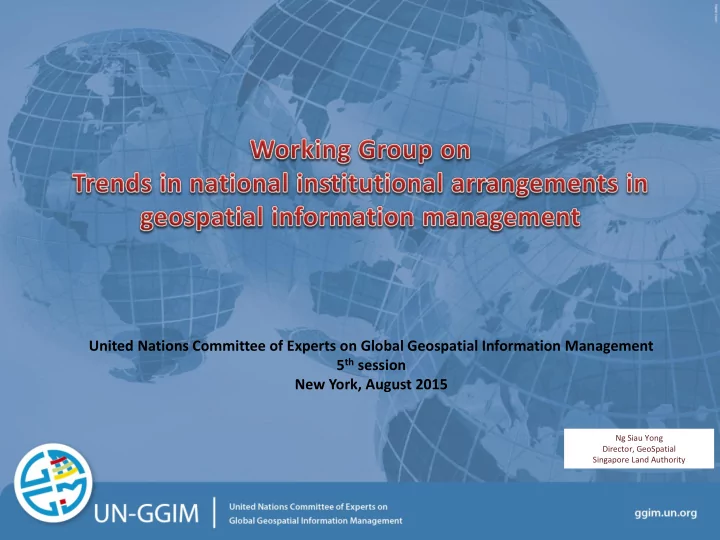

United Nations Committee of Experts on Global Geospatial Information Management 5 th session New York, August 2015 Ng Siau Yong Director, GeoSpatial Singapore Land Authority
Growing Implementation of National Initiative in GIM Stages of GIM Development Significant Changes in GIM Planning i. Implementing new policies 10% ii. Establishing new committees Inception 8% iii. Increasing participation of In Operation stakeholder 55% In Developme nt 27%
Participation in National Institutional Arrangement Creates and supplies geospatial data Provides technology and Assures geospatial infrastructure data quality Creates geospatial Provides skills services training 10 Monitors national Conducts R&D 30 GIM development 50 70 Makes strategic decisions Government Contributes/Develops on national GIM Academia GIM policies NGO Drives use of geospatial information Private Sector
Enabling a Successful GIM GIM Governance Policies GIM Areas of Emphasis 67% 57% Coordination & collaboration among entities Data Sharing 51% 41% Infrastructure & technological facilitation Open Data 39% 49% Data/Service Standards Policy & decision making 25% 31% Capacity building & adoption Data/Service Pricing 31% 12% Diverse representation in NIA Intellectual Property Rights 8% 12% Accountability, monitoring & regulation Competition Policy
Enabling a Successful GIM – Areas of Emphasis Coordination & Collaboration Infrastructure & Technological Policy & Decision Making Among Entities Facilitation 73% 63% 60% Europe 75% Arab States Americas 27% Asia & Pacific Africa
Enabling a Successful GIM – Areas of Emphasis Coordination & Collaboration Infrastructure & Technological Policy & Decision Making Among Entities Facilitation 53% 44% 60% Europe 50% Arab States Americas 18% Asia & Pacific Africa
Enabling a Successful GIM – Areas of Emphasis Coordination & Collaboration Infrastructure & Technological Policy & Decision Making Among Entities Facilitation 53% 38% 40% Europe 50% Arab States Americas 18% Asia & Pacific Africa
Enabling a Successful GIM – Governance Policies Data Sharing Open Data Data/Service Standards 80% 63% 80% Europe 100% Arab States Americas 45% Asia & Pacific Africa
Enabling a Successful GIM – Governance Policies Data Sharing Open Data Data/Service Standards 67% 56% 60% Europe 100% Arab States Americas 9% Asia & Pacific Africa
Enabling a Successful GIM – Governance Policies Data Sharing Open Data Data/Service Standards 67% 50% 60% Europe 100% Arab States Americas 18% Asia & Pacific Africa
VGI Landscape Citizens are leading contributors Citizens are leading users VGI is in the early-stage Importance of VGI Leading Contributors Leading Users High Others No Very GIM 8% National 6% Answer Others High 8% 10% Medium 7, 7% 5% 6% Private 34% No Sector Citizens Private No Answer 17% 28% Sector Answer 6% 17% 14% Citizens 21% Non- Very NGO Govern Low Low 19% ment Experts 16% Expert 24% 15% 21% 18%
Tradeoff for Usage of VGI Advantages of VGI Weakness of VGI Data No Answer, Low Cost, 27, 6% 23% Others, 2% Security, 10% Assurance or Quality, 28% Reliability, 27% Others, 2% No Answer, 6% Update, 30% Difficulty, 14% Speed, 29% Wrong Data, 23%
Areas of Further Study National Institutional Arrangement i. Development of self-assessment tool ii. Identification of best practices on GIM Volunteered Geographic Information i. Identify the advantages & weaknesses of VGI from the user perspective ii. Develop best-practices concerning the use of VGI
Thank you for your participation
Recommend
More recommend